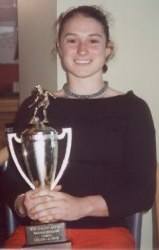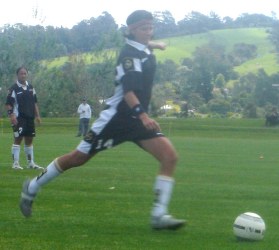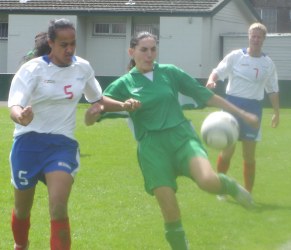The Ultimate New Zealand Soccer Website | home
Classic Matches | Stars | Five Year History | 2002 | 2003 | 2004 | 2005 | 2006 | 2007 | 2009 | Roll of Honour | Challenge Cup
Five Year History
Five Years Of The National Women's League
by Jeremy Ruane
2002 saw the introduction of the National Women's Soccer League, a seven-or-eight team round-robin affair which replaced the long-standing National Women's Soccer Tournament as the provincial showpiece of the women's soccer season.
While the National Tournament certainly had its benefits, it also had its drawbacks, not the least of which was its “survival of the fittest” element, as teams played a game - sometimes two - per day during the course of the week-long event to determine the national champions.
The women's game, as we know, places far greater emphasis on skill and technical prowess than is witnessed in the more physically focused men's version of the code, and the change to a league format has allowed these elements to shine in abundance.
The inaugural season saw the seven federations joined by the New Zealand U-17s, the spare slot used by NZ Soccer at their discretion to field a Development Squad, the age of which is determined by the requirements of upcoming international plans.
A new trophy also came as part of the package, while the old National Tournament championship trophy was also utilised in the new competition, and given a new lease of life as the New Zealand Women's Soccer Challenge Cup.
The old saying “The more things change, the more things stay the same”, applied to at least one aspect of the national body's new toy - Auckland, as they had done so often in the National Tournament era, clinched the title, albeit on goal difference from Mainland Soccer.
The “A Team”, who won the new league's maiden fixture when downing Capital Soccer 3-0, repeated their title triumph in 2003, again on goal difference, with Capital Soccer the combination denied this time round, and Central Soccer two points adrift.
The 2004 season saw the advent of play-offs, with the round-robin winner enjoying home advantage in a Grand Final against the winner of a play-off between the second- and third-placed finishers.
Central and Capital swapped positions in finishing behind placeCityAuckland, with the Wellingtonians only making the play-offs after it was deemed that Mainland had fielded an ineligible player in their round-robin clash. The result - and the positions on the table - were, crucially, reversed.
That element of fortune favoured Capital in the play-off against Central in Palmerston North, where the momentum the Wellingtonians gained from their penalty shoot-out win helped them upset the reigning champions in the inaugural Grand Final, goals from Patrice Bourke and Angela Goodridge sandwiching a Sarah Gibbs strike for the beaten team.
The 2005 campaign had more than a hint of confusion about it, after NZS, in direct contrast to their own published league regulations, opted not to include the results of the NZ U-19s in the Lion Foundation-
|
 Liz O'Meara, the inaugural Golden Boot winner
 2005 Young Player of the Year, Caitlin Campbell
 Maiden NWL goalscorer, Kristy Hill (Auckland) and double Golden Boot winner, Ella Wiebe (Central)
 2005 Grand Final action featuring Auckland's two-goal heroine, Maia Jackman, and Angela Goodridge (Capital)
|
sponsored competition's standings.
That Development Squad, the nucleus of which went on to represent this country with such aplomb on the world stage this year, actually topped the table after seven rounds of action, but it was Capital's honour per the standings issued by the national body, which meant the title-holders would host the Grand Final.
Auckland and Central disputed the right to oppose them, and the team which recorded the National Women's League's biggest-ever victory in this campaign - a 12-0 rout of Soccersouth - made no race of it, and carried their form onto a Newtown Park stage which featured a two-goal salvo from Maia Jackman as the “A Team” regained the crown courtesy a 4-2 triumph.
The 2006 campaign has witnessed something of a changing of the guard further down the table, with perennial strugglers and wooden spoon disputers Waikato-Bay of Plenty and Soccersouth enjoying much improved seasons, while the likes of Mainland and Central found the going increasingly more challenging as North Harbour held station in mid-table yet again.
But the only teams to have won the National Women's League proved themselves far and away the best combinations once more, although their showdown at Douglas Field saw the “A Team” dominate their rivals in no uncertain terms.
The 2006 Grand Final offered Capital the chance for revenge, having seen off the threat of Waikato-Bay of Plenty in last Sunday's play-off, the beaten team emerging as the best of the rest after trailing in the third-placed NZ U-18s, who were ineligible to win the competition.
Later in the month, the U-14 and U-16 Girls Tournaments in Napier concluded the women's action for the 2006 year, but all eyes on December 2 turned to Mt. Smart Stadium, where Auckland and Capital once again did battle for nationwide supremacy on the Lion Foundation National Women's League's ultimate stage, the "A Team" winning 3-1.
Auckland players have dominated the Player of the Year award since its introduction in 2003. Amber Hearn was the first recipient, followed by Michele Keinzley (now Clarke) and Rebecca Tegg, who also took out the Golden Boot award in 2005.
Her predecessors in the goalscoring stakes include Liz O'Meara (North Harbour, 2002), while Ella Wiebe (Central, 2003 & 2004) shared the trophy on both occasions, with team-mate Emma Boyack initially, then with Clare Warner (Mainland).
Caitlin Campbell (North Harbour) was the inaugural recipient of the Young Player of the Year crown in 2006, while other noteworthy league milestones belong to Kristy Hill (Auckland), who scored its first goal on 12 October, 2002, and Emily McColl (NZ U-17s), who struck the league's first hat-trick in their clash with Soccersouth sixteen days later.
|